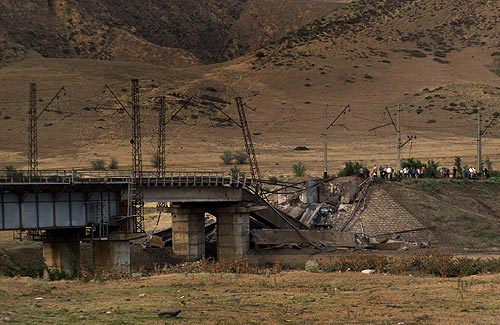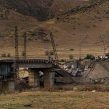
RUSSIA PREPARING TO SPLINTER GEORGIA AFTER SARKOZY-BROKERED ARMISTICE
Publication: Eurasia Daily Monitor Volume: 5 Issue: 158
By:

The Kremlin is not honoring the French-brokered agreement on cessation of hostilities and troop withdrawal from Georgia. Russian troops are roaming and rampaging at will through parts of Georgia and are preparing to seize chunks of its territory for the long term. Meanwhile, Russia brandishes the threat to dismember the entire country. Such threats reflect Moscow’s goal to reduce Georgia to political obedience by changing the country’s government.
In the process, Moscow embarrasses French President Nicolas Sarkozy by casting doubt on his promise to secure the withdrawal of Russian troops from Georgia. The Russians are even asking Georgia through Sarkozy to accept larger “security zones” under Russian control in Georgian territory, as a price for implementing the Sarkozy-brokered agreement, which heavily favors Russia in the first place (see EDM, August 13).
Russian troops and their local proxies now fully occupy South Ossetia and Abkhazia. Authorities loyal to Tbilisi, which operated in parts of those two regions, have been expelled, and the Georgian populations forcibly evicted. Statements by Russian officials from President Dmitry Medvedev and Minister of Foreign Affairs Sergei Lavrov on down clearly suggest that they regard these territorial changes as permanent (Interfax, Itar-Tass, August 14-17).
In addition, Russian forces have seized several districts inside Georgia beyond South Ossetia and Abkhazia, contiguous to them but never previously contested. Such areas include Zugdidi and Tsalenjikha near Abkhazia, and Gori and Akhalkagori near South Ossetia. The Russians seem to be turning these newly occupied areas into buffer zones that would separate South Ossetia and Abkhazia from the rest of Georgia (Civil Georgia , Kavkas-Press, August 14-17).
In these districts, the Russians seem to be setting up a system of dual power. Georgian civil authorities and police are allowed to operate partially, under limitations defined by Russian military occupation authorities and in coordination with them. These arrangements seem tentative and temporary at this stage.
The Russians may have in mind replicating here the system they created in Moldova’s city of Bendery, which is a buffer zone between right-bank Moldova and the secessionist Transnistria on the left bank of the Nistru River. In Bendery, Moldovan police are tolerated but must operate in coordination with the Russian military komendatura, whose chief (usually a Russian army colonel) settles any disputes between Moldovan and secessionist authorities in that buffer-zone city.
Moreover, the occupying forces seem intent on isolating certain remote districts from the rest of the country. Thus, the Russians have destroyed the crucial road bridge that connects the mountainous Svaneti district (adjacent to Abkhazia and Russia) from the rest of Georgia.
Deep inside Georgia, Russian forces have cut the country into an eastern half and a western half by blocking railway and highway traffic. The Russians have blown up the railway bridge at Kaspi and seized the highway junction near Gori, interdicting all transport. As a result, the government in Tbilisi has lost all overland links with the west of the country and parts of central Georgia. Air links between eastern and western Georgia are also blocked by the Russians.
Russian troops control Georgia’s Black Sea harbor of Poti and adjacent areas and are discouraging commercial vessels from entering the ports of Poti and Batumi. The Russian navy, deployed off Georgia’s coast, is engaged in undeclared or semi-declared blockade measures. The maritime blockade and interdiction of overland communications from the ports to the rest of the country has largely isolated Georgia economically from the outside world.
In sum, Russia threatens to cut up Georgia, informally but methodically, on several levels: 1) in Abkhazia and South Ossetia; 2) through additional buffer zones (glacis) beyond the secessionist areas; 3) by isolating some remote chunks of territory (Svaneti); 4) by cutting off the country’s east and west from each other and isolating Tbilisi; and 5) by controlling the seaboard.
Cumulatively, these moves enable Moscow to threaten to dismember Georgia as a means to force a change of government in Tbilisi. In the next stage, Moscow may try to install local authorities in various parts of the country. Those authorities may then be forced to act without Tbilisi’s approval or even to declare insubordination to Tbilisi. Pro-Moscow groups are a very small fringe in Georgia. The Russians, however, can create supply problems and law enforcement difficulties in order to force local authorities to work with Russian occupation authorities, even if the latter refuse to work with the Georgian government.
Reopening Georgia’s ports and restoring east-west road and railway traffic is therefore politically crucial to maintaining Georgian statehood in the face of Russia’s overt attempts to destroy the country.




